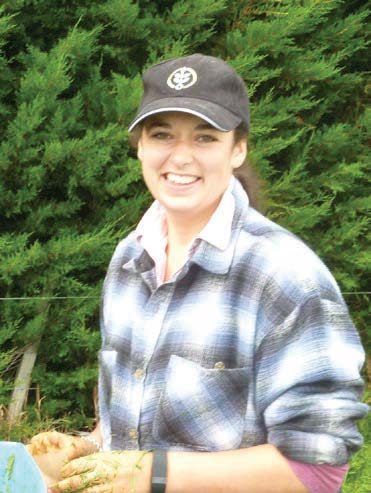By Anne Lee
Women and girls have been under-represented in science both at high school and tertiary levels but at Lincoln University a group of smart young women are bucking that trend while simultaneously coming up with findings on one of the most vexing issues facing dairy farmers.
All have been doctoral students focusing on forages that can reduce nitrate leaching – some investigating what forages are best at reducing nitrate losses and others looking at how to optimise the plants’ production in the farm system.
Farmers at the South Island Dairy Event (SIDE), held at Lincoln University earlier this year, appeared heartened not only by the potential of the research findings presented by the five but also by the very potential the five exhibited themselves.
Culverden dairy farmer Emlyn Francis attended their workshop and said the work presented by the young scientists added to the confidence he has that science will find the answers to environmental challenges.
“I am an eternal optimist and I’m very confident that science will help us out with the environmental issues we’re facing.
“Having these great, young, enthusiastic scientists doing this kind of research is definitely to our advantage. What they’re working on is exciting stuff,” he said.
DairyNZ senior scientist Ina Pinxterhuis has led the Forages for Reduced Nitrate Leaching programme and says the research carried out by the PhD students has provided valuable information for what’s going on at a urine patch level.
The next step is working out how they fit into a farm system.
One issue is that while greater nitrogen uptake and plant yield can reduce soil mineral nitrogen it could also result in more cow grazing days which could negate some of the beneficial effect.
“The farm system puzzle is what we’re working on now,” Ina said.
Dr Roshean Woods

Roshean Woods’ PhD studies confirmed the enormous potential alternative pasture species have to help farmers meet environmental limits with one experiment showing an 89% reduction in nitrogen leaching from a urine patch.
At SIDE Roshean said that by using lysimeters she was able to compare the nitrogen losses under various pasture mixes when cow urine was applied.
Losses under the urine patch are the critical environmental risk because of the high concentrations of nitrogen in cow urine.
Initially Roshean looked at the effect of growing Italian ryegrass, comparing it to a traditional ryegrass-white clover sward.
It was chosen because of its coolseason activity and Roshean explained one approach to limiting nitrogen losses is to use plants that take up more nitrogen – especially during the cooler months when the risk of leaching is greatest.
One experiment, featured in the Dairy Exporter, November 2016, showed among other things that leaching losses from a urine patch under Italian ryegrass were 35% lower than under a perennial ryegrass-white clover sward.
Her investigation suggested the reduction in losses in the Italian ryegrass sward were due to increased cool season growth with that species taking up 2.1kg N/ha/day on average compared with 1.6kg N/ha/day for perennial ryegrass-white clover.
Her initial studies used urine with a standardised urinary nitrogen content but she then went on to simulate a situation that would more-closely reflect the on-farm environment and used urine from cows that
had grazed the forages she was testing.
She also expanded the alternative pasture mix to include plantain so the comparison was done between a typical ryegrass-white clover sward and an Italian ryegrass plantain-white clover mix.
If the urine was standardised (at 700kg N/ha) she found the inclusion of the plantain meant even less nitrogen
was lost with her results showing a 45% reduction in nitrate leaching from a urine patch compared with the typical ryegrass-white clover mix.
But when the urine was from cows grazing the respective mixes, she found a dramatic drop of 89% in nitrate leached from a urine patch for the Italian ryegrass-plantain-white clover mix compared with ryegrass-white clover.
The concentration of nitrogen in the urine of cows grazing the alternative forage mix was 508kg N/ha – significantly lower than the 664kg N/ha concentration in the urine from cows grazing ryegrass-white clover.
Importantly she also found there was no significant difference in drymatter yield between the two forage types.
Roshean has been awarded her PhD and is now working at AgriMagic in Canterbury as a farm environmental consultant.
Lisa Box

Lisa Box’s studies looked at the urinary nitrogen concentration and urine volumes of cows grazing plantain as well as any effect on milk production. She found that when plantain made up half the sward along with a ryegrass/white clover mix, urinary nitrogen concentrations were reduced by 33%.
If cows only grazed plantain their urinary nitrogen concentrations were more than halved at 56% lower than cows grazing ryegrass/white clover. The study was carried out over a 10-day period in autumn with cows grazing either plantain only, 50% plantain and 50% ryegrass-white clover, or ryegrass-white clover only.
Milksolids production was greater for cows grazing plantain only (1.67kg MS/cow/day) than those grazing pasture (1.50kg MS/cow/day), with milksolids production from cows grazing the 50-50 diet intermediate (1.60 kg MS/cow/d).
Other studies have found urinary nitrogen concentrations are directly related to the amount of nitrogen cows take in with their diet – the more nitrogen in the forage the more nitrogen in the urine. But in her experiments there was no difference in the apparent nitrogen intake between pasture and plantain indicating something else may be at play.
Lisa also measured urinary volumes and found cows excreted a greater total volume of urine on a daily basis if they grazed forage where plantain was included.
Using the concentration and volume data she collected and assuming a urine patch size of 0.2m2 Lisa was able to calculate the urine nitrogen loading from cows on pasture was about 700kg N/ha in autumn and 670kg N/ha in spring. The good news for farmers was that cows grazing plantain would have an N loading of about 450kg N/ha in autumn and 320kg N/ha in spring. Lisa has submitted her PhD thesis and hopes to work in the Waikato region in the agronomy or sustainability areas.
Anna Carlton

Anna Carlton’s PhD studies looked at irrigation and the effect this can have on nitrogen loss, but rather than investigating the effect of over-irrigation and drainage Anna looked at what happens if not enough water is applied.
She wanted to quantify the effect of optimum versus deficit irrigation on the uptake of nitrogen by diverse and typical forage plants and also on the losses from spring deposited urine.
Her experiments set out to test the theory that optimum irrigation improves plant growth and therefore nitrogen uptake during the summer months.
The diverse pastures included a mix of perennial ryegrass, white clover, red clover, prairie grass, plantain and chicory while the “standard” mix included perennial ryegrass and white clover only.
Anna applied urine at two concentrations – either 500kg N/ha/year or 700kg N/ha/year and then subjected her trial plots to either optimum or deficit irrigation from November to March.
She told the SIDE audience that at a urinary nitrogen concentration of 700kg N/ha initial leaching losses from the urine patch under optimum irrigation were 88-97% lower than those from deficit irrigation regardless of whether the pastures were diverse or standard.
The results showed that adequate moisture over summer improved soil nitrogen use by plants and reduced nitrogen leaching from spring-deposited urine in grazed pastures.
Anna has submitted her PhD thesis and is working in the environmental team at Ravensdown.
Grace Cun

Grace’s studies centred on grazing management for diverse pastures and looked at whether lax grazing in one rotation followed by pregraze mowing in the next could improve both pasture and milk yield.
Grace explained that lax grazing was where the sward was allowed to get to a slightly higher pre-graze cover and that rather than grazing to 1500-1600 kg drymatter (DM)/ha, the post grazing residuals were allowed to be at 1800-1900 kg DM/ha. A lax grazing regime may improve pasture persistence.
While a lax grazing regime may improve pasture persistence she said it was known that leaving behind a higher pasture residual in spring could reduce the quality of the sward in the subsequent grazing leading to a drop in milk production. Her research aimed to find out if the pasture species included in “diverse pastures”, which can help reduce nitrate leaching potential, would be similarly affected by a lax grazing regime and whether that would have the same effect on milk production.
She found that the lax grazing regime in spring coupled with a longer rotation length of 27 days rather than 21 days, led to a greater pre-grazing mass equivalent to more than 1000kg drymatter (DM)/ha but it also contributed to a lower milk yield in November or during the following rotation in December.
Growth rates didn’t benefit from the lax grazing approach. While pre-graze mowing did improve the quality of the pasture in the subsequent round it wasn’t enough to improve milk yield.
It was unlikely then that a lax grazing approach to diverse pastures could provide any milk yield benefits compared with a more normal grazing management approach, she said.
Grace will complete her PhD from Lincoln University in March 2018 and her goal is researching economic feed sources (crops/forages) that are readily available in an area and determine if the crops/forages or its byproducts can be used as a feed source for dairy cattle while minimising the environmental impact without hindering milk production.
Kirsty Martin

Kirsty Martin has tackled the agronomic question of nitrogen fertiliser use when it comes to diverse pasture species, looking at different nitrogen fertiliser rates on plant yield and the nitrogen content of the diverse pasture species themselves.
Using monoculture plots Kirsty ran a cut-and-carry trial over 12 months comparing six annual fertiliser rates ranging from zero to 450kg N/ha/year.
The six forage species she investigated were perennial ryegrass, Italian ryegrass, white clover, lucerne, chicory and plantain.
Her results showed that Italian ryegrass and plantain outdid the other pasture species in terms of yield at all nitrogen fertiliser rates. She also found that once the fertiliser rate went above 180kg N/ha/year the nitrogen content of the plant itself increased too. In the grass forage species, the nitrogen content lifted from 2.4% to 2.8% while the herb species’ nitrogen content increased from 2.9% to 3.3%.
As the nitrogen content of the diet increases so too does the potential for urinary nitrogen losses and the risk of leaching. Kirsty said that while it’s apparent there are yield benefits to higher nitrogen application rates the environmental risk needs to be considered.
She said the higher response rates of herbs such as plantain meant that maintaining nitrogen fertiliser rates at the optimum for grass growth would also see benefits in yield for any plantain includedin the pasture. Kirsty noted that her experiments were cut-and-carry so there was no urinary nitrogen input from grazing animals. Under a grazing situation the yield responses are likely to show a point at which increasing nitrogen fertiliser application rates have less of an effect on yield but further increase nitrogen concentration.
Kirsty will complete her PhD from Lincoln University early next year and will start work for Canterbury-based company Dairy Farm Management Services.




